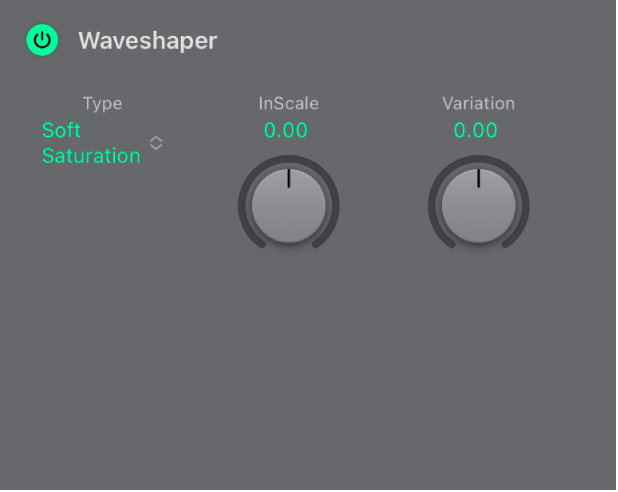Logic Pro User Guide for iPad
- What’s new in Logic Pro 1.1
-
- What is Logic Pro?
- Working areas
- Work with function buttons
- Work with numeric values
-
- Intro to tracks
- Create tracks
- Create tracks using drag and drop
- Choose the default region type for a software instrument track
- Select tracks
- Duplicate tracks
- Reorder tracks
- Rename tracks
- Change track icons
- Change track colors
- Use the tuner on an audio track
- Show the output track in the Tracks area
- Delete tracks
- Edit track parameters
- Start a Logic Pro subscription
- How to get help
-
- Intro to recording
-
- Before recording software instruments
- Record software instruments
- Record additional software instrument takes
- Record to multiple software instrument tracks
- Record multiple MIDI devices to multiple tracks
- Record software instruments and audio simultaneously
- Merge software instrument recordings
- Spot erase software instrument recordings
- Replace software instrument recordings
- Capture your most recent MIDI performance
- Use the metronome
- Use the count-in
-
- Intro to arranging
-
- Intro to regions
- Select regions
- Cut, copy, and paste regions
- Move regions
- Remove gaps between regions
- Delay region playback
- Trim regions
- Loop regions
- Repeat regions
- Mute regions
- Split and join regions
- Stretch regions
- Separate a MIDI region by note pitch
- Bounce regions in place
- Change the gain of audio regions
- Create regions in the Tracks area
- Convert a MIDI region to a Drummer region or a pattern region
- Rename regions
- Change the color of regions
- Delete regions
- Create fades on audio regions
- Access mixing functions using the Fader
-
- Intro to Step Sequencer
- Use Step Sequencer with Drum Machine Designer
- Record Step Sequencer patterns live
- Step record Step Sequencer patterns
- Load and save patterns
- Modify pattern playback
- Edit steps
- Edit rows
- Edit Step Sequencer pattern, row, and step settings in the inspector
- Customize Step Sequencer
-
- Effect plug-ins overview
-
- Instrument plug-ins overview
-
- ES2 overview
- Interface overview
-
- Modulation overview
-
- Vector Envelope overview
- Use Vector Envelope points
- Use Vector Envelope solo and sustain points
- Set Vector Envelope segment times
- Vector Envelope XY pad controls
- Vector Envelope Actions menu
- Vector Envelope loop controls
- Vector Envelope release phase behavior
- Vector Envelope point transition shapes
- Use Vector Envelope time scaling
- Use the Mod Pad
- Modulation source reference
- Via modulation source reference
-
- Sample Alchemy overview
- Interface overview
- Add source material
- Save a preset
- Edit mode
- Play modes
- Source overview
- Synthesis modes
- Granular controls
- Additive effects
- Additive effect controls
- Spectral effect
- Spectral effect controls
- Filter module
- Low and highpass filter
- Comb PM filter
- Downsampler filter
- FM filter
- Envelope generators
- Mod Matrix
- Modulation routing
- Motion mode
- Trim mode
- More menu
- Sampler
- Copyright
Use Sculpture Waveshaper in Logic Pro for iPad
The Waveshaper imposes a nonlinear shaping curve on each voice of the signal coming from the pickups and amplitude envelope. This reshaped signal is then passed on to the filter. This process is quite similar to the waveshaping of oscillators in synthesizers such as the Korg O1/W.

Waveshaper parameters
Waveshaper On/Off button: Turn the Waveshaper on or off.
Type pop-up menu: Choose one of four waveshaping curves. See the table.
InScale knob: Cut or boost the input signal, prior to processing by the Waveshaper. Positive values result in a richer harmonic spectrum. Any level increase introduced by this parameter is automatically compensated for by the Waveshaper. This parameter can be morphed.
Note: Given its impact on the harmonic spectrum, InScale (Input Scale) should be viewed and used as a timbral control, rather than a level control. Also note that extreme InScale values can introduce processing noise at the Waveshaper output.
Variation knob: Set the value of the preassigned parameter for the selected Waveshaper curve. Behavior varies between curve types. This parameter can be morphed. See the table.
Type | Variation controls | Value of 0.0 | Negative values | Positive values |
|---|---|---|---|---|
Vari Drive | Wet/dry ratio | Provides shaped signal only. | Reduces shaped signal and adds dry signal. | Raises shaped signal and adds phase-inverted dry signal, making sound sharper. |
| Bias—alters the symmetry of the shaping curve. | Results in symmetrical shaping. | Alters symmetry. | Alters symmetry. |
Download this guide: PDF